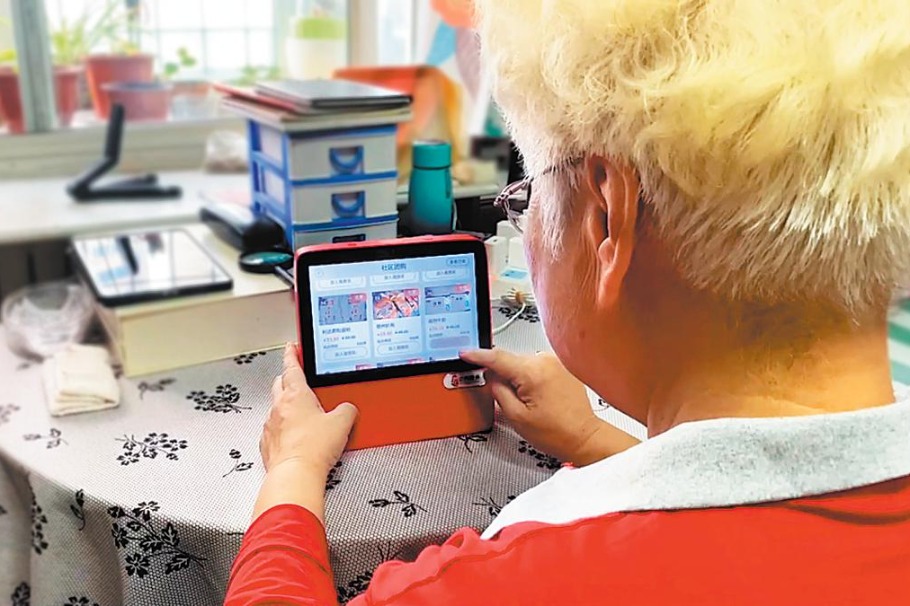For those who can study or work from anywhere
Remote working is picking up in a big way in a country which is largely confined indoors due to the ongoing epidemic

Unlike Americans, says a survey, Chinese are among the least willing to completely work from home. But the same survey by Gartner Inc, the world's leading information technology research and advisory company, also says Chinese yearn to work from anywhere.
And that innate ability has come in handy with the novel coronavirus outbreak forcing many indoors to avoid infection. During this period, digital tools have helped businesses normalize operations without employees incurring the risk of cross-infections.
Large-scale work-from-home exercises in China had a slow start in February but pushed the use of remote working tools, enabling trans-world video conferencing and nationwide online classes, as most schools are shut.
"The novel coronavirus has indeed instigated a significant fresh opportunity for both employers and suppliers of corporate remote working technology," says Gavin Tay, senior research director at Gartner Inc. "The technology available today has come a long way since the last outbreak, of severe acute respiratory syndrome (SARS) in 2003. Without the advancement in network infrastructure, such technologies will not have advanced either."
According to metrics research firm App Annie, if daily downloads since February are any indication, DingTalk, an enterprise communications tool, has become one of the most sought-after mobile apps from Apple's App Store in China.
At the root of this app's sudden popularity is the demand by users from not just for-profit organizations but also social entities and China's multimillion-dollar education sector.
For instance, DingTalk has been facilitating online courses in 140,000 schools and 2.9 million classes in China, covering 120 million students in more than 30 regions. The app has helped some 3.5 million teachers transform into anchors taking online classes.
Also gaining ground is Tencent Holdings' WeChat Work, the enterprise version of the messaging app WeChat. As many businesses use the software, the company was even able to compile a report depicting the behavior and working habits of employees across regions and industry.
For instance, it found that video conferencing is used most in Shenzhen and Shanghai, while education, healthcare and government agencies meet maximum business requirements through the software.
Compared to the West, China's enterprise software industry has been slow to take off, says Raymond Wang, global partner at consultancy Roland Berger. "Roughly 20 percent of office workers in Europe and the United States are familiar with distance conferencing, whereas its penetration rate in China is between 1 to 2 percent," Wang said. "There's definitely plenty of room for growth."
However, the current epidemic has expedited its adoption. Wang sees it emerging as a 10 billion yuan ($ 1.41 billion) business in China, but admits the estimate may not be accurate given the wide spectrums that define the sector.
"And they are designed to serve different purposes," Wang says. For instance, WeChat Work has fully leveraged the ubiquity of WeChat in China, thus lowering the threshold for literally anyone to join in a meeting by clicking a link via WeChat. "In contrast, users of Huawei's WeLink will need to go through a registration process and wait for approvals before joining a meeting. Organizers also have strict control over the conference flow. It's designed probably to target more business scenarios with stringent security requirements," Wang said.
The market has opportunities. People are also embracing Huawei's WeLink and Bytedance's Feishu for virtual morning meetings and remote team collaboration work. Leading foreign rivals include Lark, Zoom and Slack, to name a few.
According to Tay, China's Huawei and ZTE are already a challenge to Microsoft, Zoom and Cisco.
"Such enterprises headquartered in China sometimes offer solutions that most other vendors lack," Tay said. "In some cases, they set the trend and have a track record of responding to changing market conditions."
DingTalk and WeChat Work stand out against a growing number of smaller players like WhatsApp in English-speaking nations and Line in Japan, Tay said. But software from China is also making a mark internationally. DingTalk, for instance, was among 60 distance learning solutions recommended by the United Nations as the international community turned to technology to minimize the impact of the novel coronavirus outbreak.
UNESCO has published a list of educational applications and platforms in six categories on its website as ways to "facilitate student learning and provide social caring and interaction during periods of school closure". DingTalk was included under "collaboration platforms that support live-video communication"; two other Chinese companies, Mosoteach and iCourse, also made it to the list.
UNESCO said these solutions do not carry its explicit endorsement, but emphasized that they have a wider reach, a strong user base and evidence of impact.
According to UNESCO monitoring, over 160 countries have implemented nationwide closures, impacting over 87 percent of the world's student population.
To meet demand, DingTalk has unveiled its latest 5.0 version, including functions like office tools that can simultaneously be edited by multiple users and tiered virtual community groups.
"DingTalk hopes to become the infrastructure of a digital society. We are not building for games, but for the healthy development of society," said its CEO Chen Hang.
More and more companies across the globe are looking to use technology for a concerted solution.
In the latest instance, WeChat and TikTok are joining with global industry peers to launch the COVID-19 Global Hackathon starting March 26, which invites developers to build locally or globally focused software solutions that tackle the challenges brought by the virus.
The consortium has connected with a range of partners including the World Health Organization to understand roughly seven key challenge areas that technological innovation could help solve, which include collaborative work tools that support more employees working from home.
"We hope to encourage more creations based on the WeChat open platform that can tackle COVID-19 challenges faced by people overseas, after many such Mini Programs have effectively helped people in China," Tencent said in a statement to China Daily.
"We will help select projects with the greatest social impact, provide technical support and facilitate their implementation where relevant."
But the market is still largely fragmented, with very few apps playing a dominant role. For instance, Ding-Talk is predominantly used in China, while some other apps are used for communication in Islamic regions.
Cultural element is definitely at play, says Tay. "Enforcing remote work requires a complete trust in workers and a change in workplace policies as well as metrics," he said.
No wonder, DingTalk received a rather low rating on app stores from new users, including company employees and students. The reason? The app can, theoretically, put people at work around the clock. "It's not work from home-it's like working 24/7, with the software tracking our whereabouts," said an employee of a Shanghai-based software company on condition of anonymity.
Still, experts are looking at the brighter side. Wang believes the market requires technologies to be coupled with tailored software, hardware and even content modules that pair perfectly with distance communication.
"For instance, a content creation software incorporating common scenarios in business discussions (such as organizational charts) will certainly become a killer app," he said. "And for Chinese technology providers to excel in overseas markets, it's imperative to understand cultural nuances regarding local needs and habits, and conduct targeted marketing."


Today's Top News
- Trump says US completes trade deal with Japan
- Washington announces leaving UNESCO again
- More occupations bolstering China's employment market
- Is US tariff deal good or bad for Indonesia?
- Hainan's customs closure a milestone
- Innovation, solid supply chain attracting FDI






























